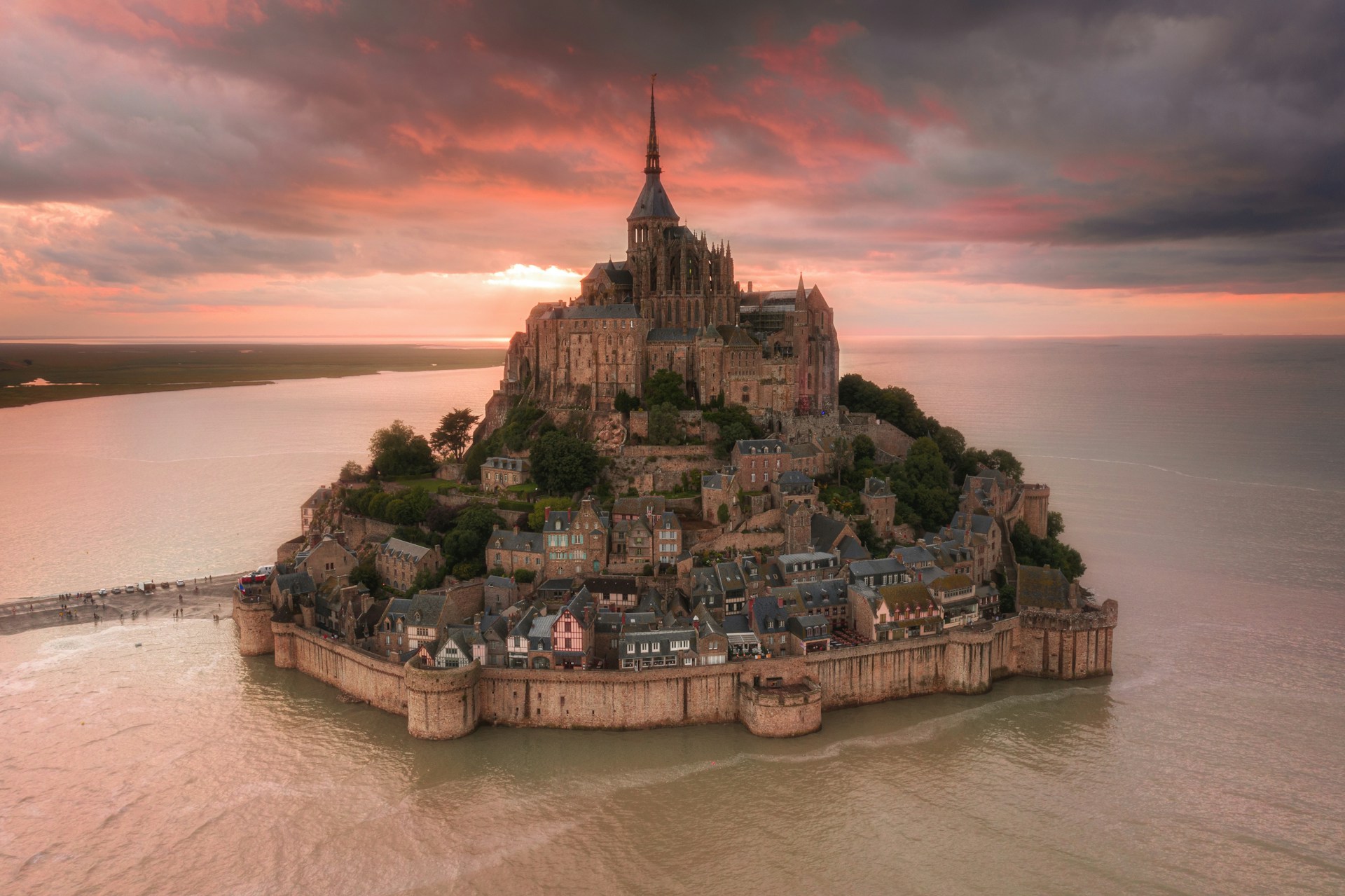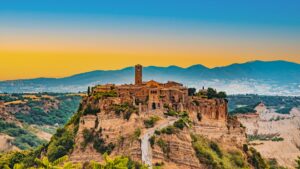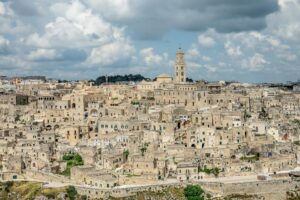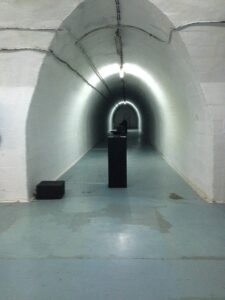Welcome to Mont St. Michel, the jewel of Normandy, France! This guide will help you navigate through the enchanting island and ensure you make the most out of your visit. Whether you’re a history buff, a food lover, or simply in search of breathtaking views, Mont St. Michel has something for everyone.
Geographic Location
Mont St. Michel is perched on a rocky islet in Normandy, France, surrounded by magnificent tidal flats and powerful tidal waves. It’s about one kilometer off the country’s northwestern coast at the mouth of the Couesnon River near Avranches. Accessible by a causeway which is covered at high tide and revealed at low tide, the dramatic setting makes it one of France’s most iconic landmarks.
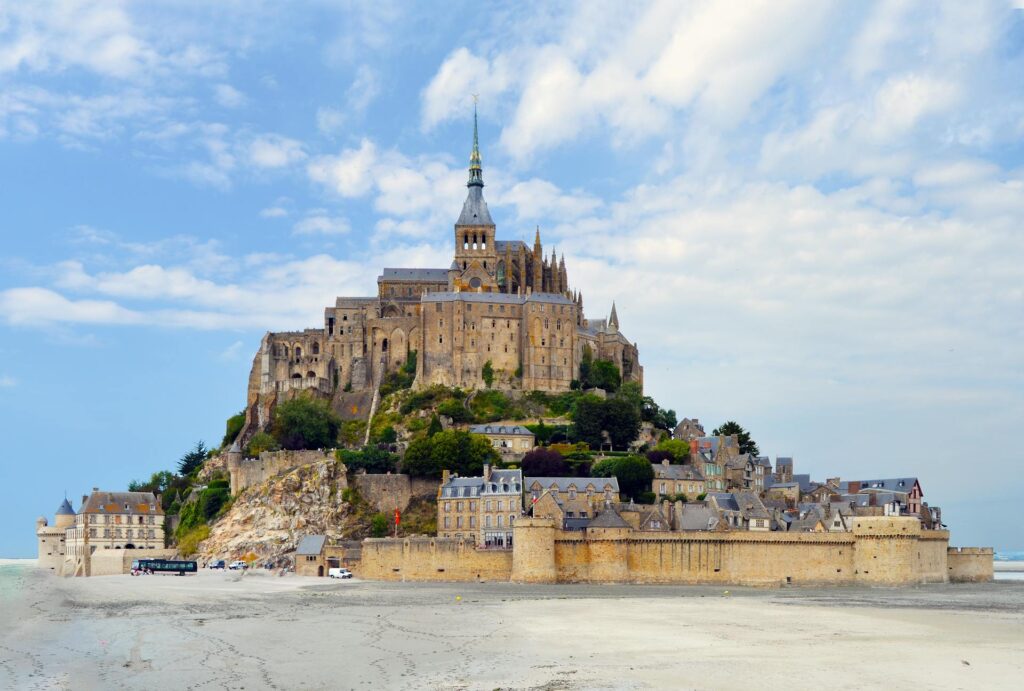
Getting There
Whether you’re coming from within France or abroad, here’s how to navigate your way to this iconic destination.
- By Air: The nearest major airport to Mont St. Michel is Rennes Bretagne Airport, located about 75 kilometers to the south. This airport offers both domestic and international flights. Another option is Paris Charles de Gaulle Airport, which is approximately 360 kilometers away but offers a wider range of international flights. From these airports, you can continue your journey to Mont St. Michel by train, bus, or car.
- By Train: The closest train station to Mont St. Michel is Pontorson-Mont St. Michel, which lies about 9 kilometers away. This station is well-connected with several major cities in France. Trains from Paris Montparnasse station to Pontorson typically involve a change at Rennes and take around 3 to 4 hours. Once you arrive at Pontorson, you can take a shuttle bus, taxi, or even rent a bicycle to reach Mont St. Michel.
- By Car: Driving to Mont St. Michel offers flexibility and scenic views along the way. From Paris, the drive takes approximately 4 hours via the A13 and A84 motorways. Well-marked signs will guide you as you approach the coast. There is a large parking lot located 2.5 kilometers from the island. From the parking area, you can walk across the causeway or take a free shuttle bus known as the “Passeur,” which transports visitors directly to the island.
- By Shuttle Bus: The “Passeur” shuttle buses run frequently from the mainland parking lots to Mont St. Michel. These shuttles are specially designed to accommodate the large number of visitors and provide a convenient and quick way to reach the island, with a journey time of about 12 minutes.
- By Bicycle: For those who prefer a more active approach, cycling to Mont St. Michel can be a delightful experience. There are designated cycling routes from Pontorson to Mont St. Michel, which offer a scenic ride through the Normandy countryside. Bicycle parking is available near the visitor parking areas, where you can then transition to the shuttle or walk.
- Walking: For the ultimate experience, you can choose to walk from the parking area to Mont St. Michel. This approximately 40-minute walk allows you to enjoy the breathtaking landscape of the bay, especially at low tide when the vast expanses of sand are exposed.
- Tidal Considerations: If you plan to drive or walk across the causeway to Mont St. Michel, it’s crucial to check the tidal schedules. The access road can be submerged during high tide, making the island temporarily inaccessible by land.
- Tour Packages: Many visitors opt for organized tour packages from cities like Paris, which include transportation and guided tours. These can be a convenient option if you prefer not to manage travel logistics yourself.
Getting to Mont St. Michel is an integral part of the experience, setting the stage for a memorable visit. Whether you choose to arrive by air, train, car, shuttle, bicycle, or on foot, each mode of transport offers its own unique perspective of this historic and magical site.
History and Culture
The history of Mont St. Michel dates back to the 8th century when, according to legend, the archangel Michael appeared to St. Aubert, bishop of Avranches, and instructed him to build a church on the rocky islet. The resultant Abbey became a major cultural and pilgrimage centre during the Middle Ages. It has survived a thousand years of tumultuous history, including sieges and prisons during the French Revolution. Today, it stands as a symbol of French national identity and resilience, and it’s a UNESCO World Heritage site.
Best Time to Visit
The ideal time to visit Mont St. Michel is during the spring and early autumn months, from April to June and September to October. These months offer mild weather, fewer crowds, and pleasant temperatures for exploring the outdoors.
Attractions
Mont St. Michel is not just an island but a doorway to the past, filled with intriguing sights and stories. Here’s a deeper dive into its key attractions:
Mont St. Michel Abbey
At the heart of the island rises the awe-inspiring Mont St. Michel Abbey, a masterpiece of medieval architecture. Founded in the 8th century, the abbey has been a beacon of religious devotion and architectural ingenuity. As you ascend the Grand Degre, or Grand Staircase, you’ll reach the abbey church, perched 80 meters above sea level, offering panoramic views of the bay and surrounding landscape. Inside, explore the cloister, refectory, and the scriptorium where monks once penned manuscripts. The abbey often hosts exhibitions and concerts, blending its historical aura with contemporary culture.

The Medieval Village
Beneath the abbey, the medieval village of Mont St. Michel winds its way through narrow cobblestone streets. This village, once bustling with pilgrims, soldiers, and artisans, now houses museums, shops, and restaurants. Key sites include the Maritime Museum, which gives insights into the tides and history of the area, and the Museum of History, home to ancient weapons, sculptures, and a dungeon. Walking through the village is like stepping back in time, with each building and alleyway telling a story of the island’s layered history.
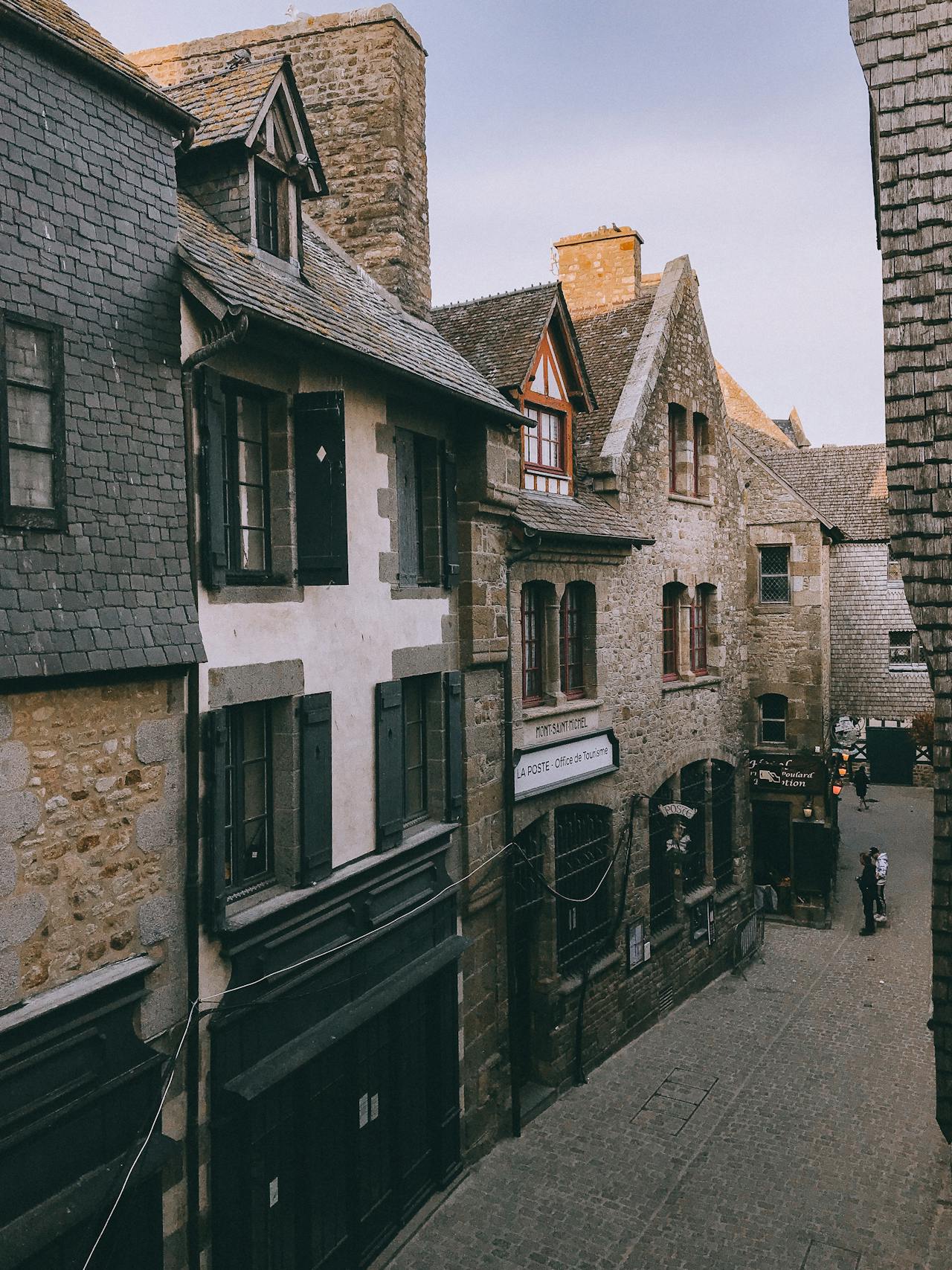
The Ramparts and Defensive Walls
Constructed to protect against English attacks during the Hundred Years’ War, the ramparts of Mont St. Michel are among the best-preserved medieval military architectures in Europe. A walk along these defensive walls offers not only a glimpse into the island’s strategic importance but also provides unmatched views of the bay, especially during sunset or sunrise. These walks reveal the strategic design of the fortifications, including arrow slits, cannon ports, and lookout points.
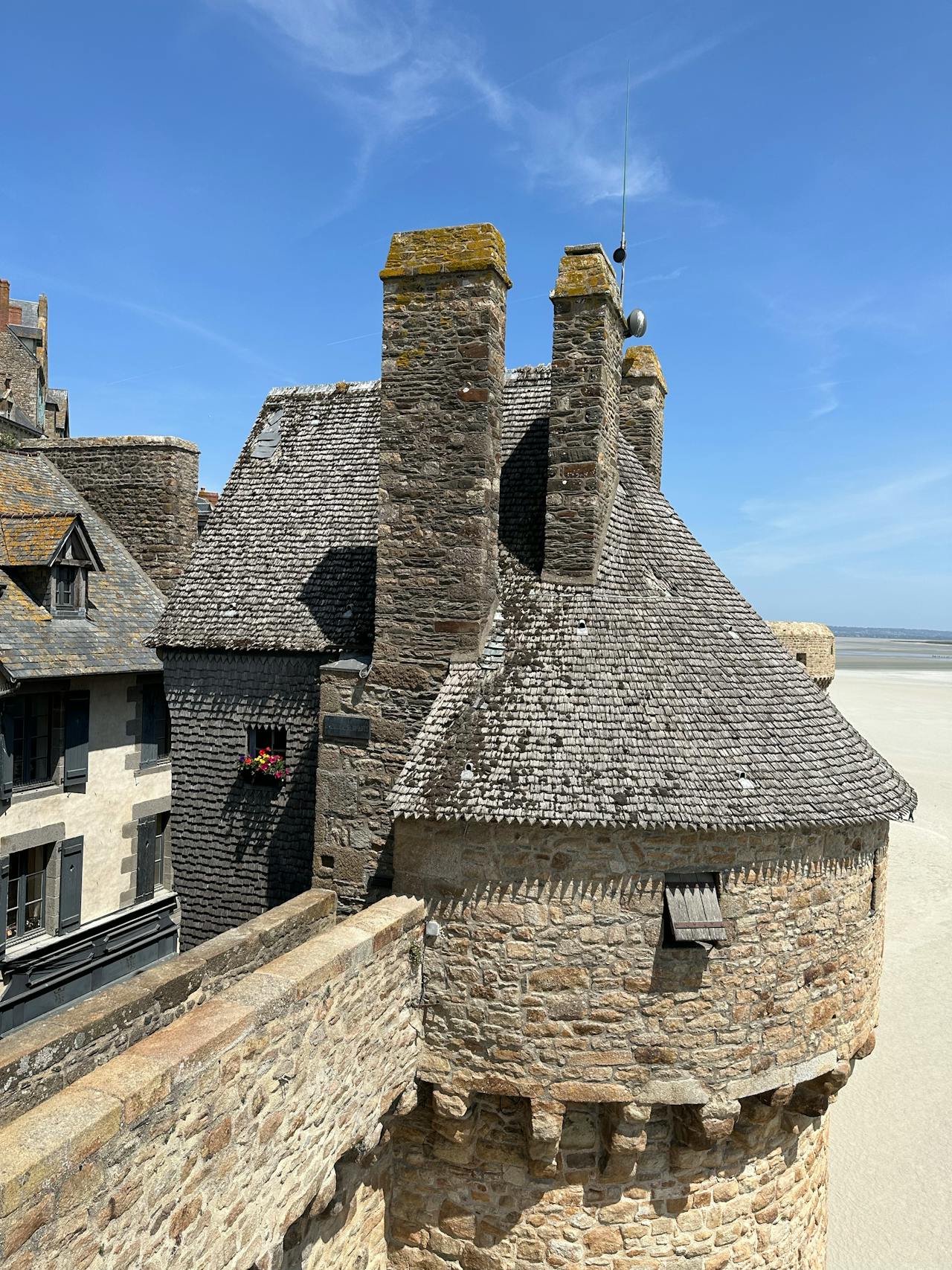
The Tidal Phenomenon
Mont St. Michel is famous for its dramatic tides, which can vary greatly, approximately 14 meters between high and low water marks. The tides can rush in at the speed of a galloping horse and are a spectacle in themselves. The best way to experience this natural phenomenon is through guided walks around the bay, available during low tide. These tours are both educational and visually stunning, offering a chance to see the island from different perspectives and understand the dynamic coastal environment.
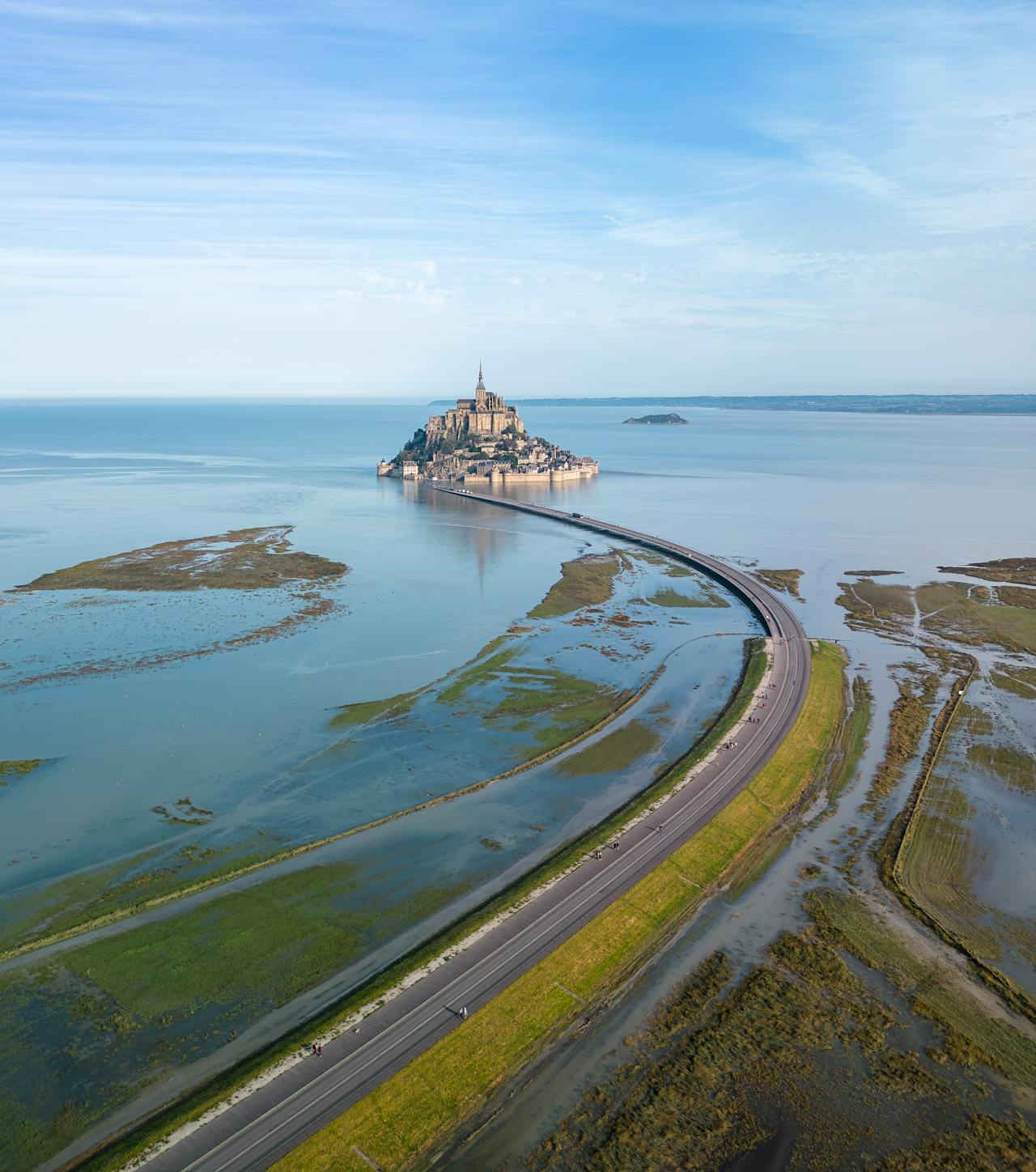
La Grande Rue
The main thoroughfare of Mont St. Michel, La Grande Rue, is lined with historic buildings that now serve as shops and eateries. This bustling street is perfect for picking up souvenirs, from medieval-inspired artifacts to local delicacies like salt meadow lamb and the famous biscuits of Mont St. Michel. As you walk up the street, it narrows, rising steeply towards the abbey, surrounded by traditional timber-framed buildings that evoke the Middle Ages.
The Church of Saint-Pierre
Near the base of the island is the Church of Saint-Pierre, a smaller yet charming parish church. This church houses a statue of Saint Michael slaying the dragon, an emblem of the island’s patron saint. It’s a quieter, more intimate space for reflection, often missed by those focused solely on the abbey above.
Each of these attractions contributes to the rich tapestry of Mont St. Michel, making it a fascinating destination for history enthusiasts, cultural tourists, and nature lovers alike.
Activities
Mont St. Michel isn’t just a stunning visual experience; it offers a range of activities that allow visitors to immerse themselves in its history, culture, and unique natural environment. Here’s a closer look at what you can do to enrich your visit:
Guided Tours of the Abbey
To truly appreciate the architectural and historical significance of Mont St. Michel Abbey, join one of the guided tours. These tours are led by knowledgeable guides who provide insights into the abbey’s construction, its role in medieval society, and the daily life of its monks. Special themed tours, such as night tours or scriptorium-focused visits, can also provide a unique perspective on this iconic structure.
Tidal Walks
The bay surrounding Mont St. Michel is known for its extreme tides, which create a stunning and ever-changing landscape. Guided tidal walks allow you to safely explore the tidal flats and sandbanks around the island. These walks are not only a great way to see the island from different angles but also offer an opportunity to learn about the local marine ecosystem and the phenomenon of the tides.
Night Visits
Experiencing Mont St. Michel by night is an entirely different adventure. The abbey occasionally opens its doors for evening tours, which let you explore its halls and crypts under the eerie and enchanting light of the moon and subtle illumination. These visits are especially memorable, providing a quiet and mystical atmosphere that highlights the spiritual and historical aura of the place.
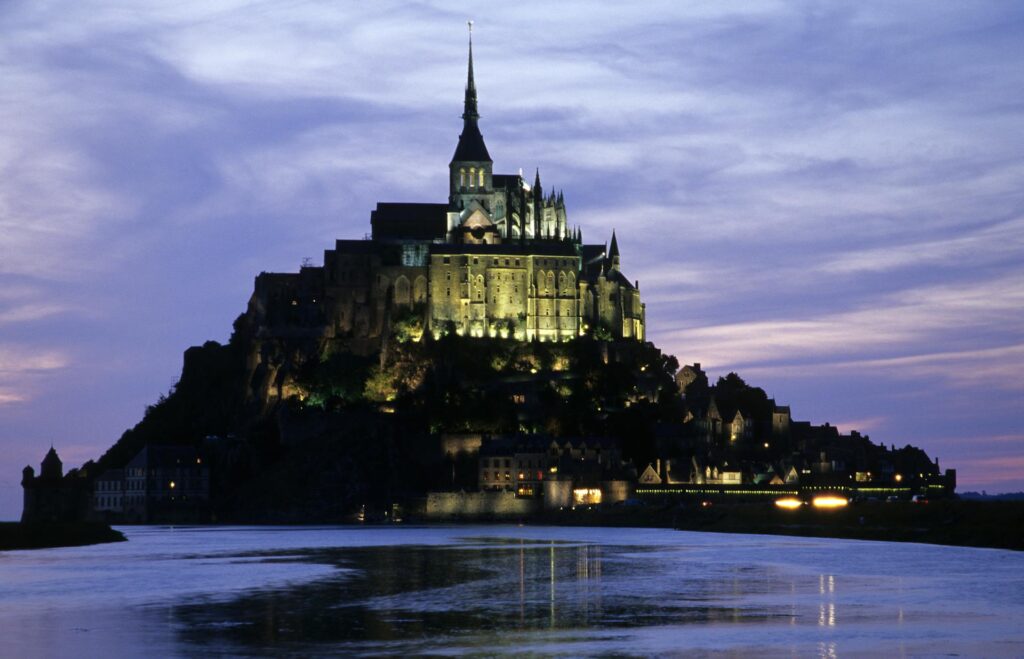
Pilgrimage Walks
For those interested in the spiritual history of Mont St. Michel, participating in a pilgrimage walk can be a profound experience. These walks typically start from various points in the surrounding region and follow the historical routes taken by medieval pilgrims. Walking these paths offers a chance to reflect on the historical and religious significance of the journey to Mont St. Michel.
Culinary Workshops
Given its reputation for unique local cuisine, particularly the famous omelets of La Mère Poulard, culinary workshops can be a delightful way to engage with the local culture. These workshops might include cooking classes where you can learn how to prepare local dishes or tastings of regional products like cider and calvados.
Photography Tours
For photography enthusiasts, Mont St. Michel presents countless opportunities for capturing stunning images. Photography tours, either guided by local experts or self-directed, can take you to the best spots for photography at the right times of day, ensuring you get the best light. These tours might focus on capturing the abbey, the village, or the dramatic tides.
Bird Watching
The surrounding bay and marshlands of Mont St. Michel are rich in birdlife, particularly during migration periods. Bird watching tours are available for nature enthusiasts wanting to observe species like plovers, egrets, and herons in their natural habitat. These tours are both educational and a peaceful way to appreciate the area’s natural beauty.
Historical Reenactments
During certain times of the year, Mont St. Michel hosts historical reenactments that bring the medieval history of the island to life. These events can include demonstrations of medieval combat, crafts, and daily life activities, offering an interactive and educational experience for all ages.
Accommodation
Finding the right place to stay is crucial for enjoying your visit to Mont St. Michel. Whether you’re looking for luxury accommodations within the walls of the Mont itself or seeking a charming countryside retreat nearby, there are options to suit every preference and budget.
Staying on the Island
Staying on Mont St. Michel itself offers a unique, immersive experience. Here are a few notable places:
- La Mère Poulard: Renowned for its historic charm and famous culinary traditions, this hotel offers comfortable rooms with period-style decorations. Staying here also means you’re right in the heart of Mont St. Michel, perfect for exploring early in the morning or late at night when the crowds have thinned.
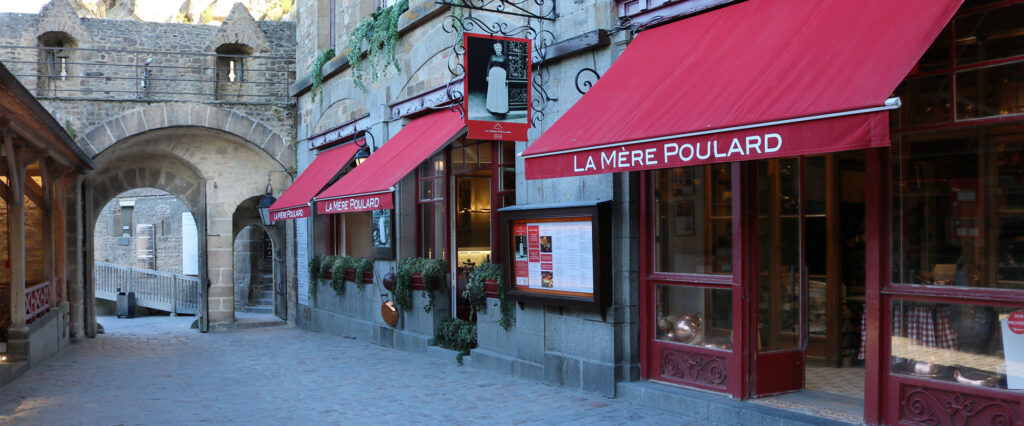
- Les Terrasses Poulard: A compilation of several historical buildings, this hotel provides rooms with stunning views of the bay or the medieval village. The rustic charm and central location make it a favorite among visitors.
- Auberge Saint-Pierre: This quaint inn offers a warm, cozy stay with rooms that blend historical architecture with modern comforts. It’s nestled within the narrow streets of Mont St. Michel and provides easy access to all major attractions.
Staying on the Mainland
For those who prefer a quieter base, the mainland near Mont St. Michel offers several options:
- Hotel Mercure Mont Saint Michel: This hotel is located close to the causeway leading to Mont St. Michel and offers modern amenities and spacious rooms. It’s ideal for families and those looking for a comfortable, convenient stay.
- Le Relais Saint Michel: An upscale hotel with panoramic views of Mont St. Michel, offering elegantly furnished rooms and fine dining options. It’s a great choice for those who wish to enjoy the view of the island from a peaceful distance.
- Hôtel Gabriel: Located near the shuttle stop to Mont St. Michel, this is a budget-friendly option with contemporary styled rooms and essential comforts.
Bed and Breakfasts
For a more intimate and personal experience, several bed and breakfasts are available in the surrounding villages:
- Les Vieilles Digues: Nestled in Beauvoir, just a few kilometers from Mont St. Michel, this charming B&B offers cozy rooms and a homey feel with a delicious breakfast made from local products.
- La Jacotière: A friendly and inviting B&B that stands out for its hospitality and excellent location, offering easy access to the island and beautiful views of the bay.
Campsites
For those who love the outdoors, there are several campsites in the vicinity where you can stay close to nature:
- Camping aux Pommiers: The first campsite you’ll encounter on your way to Mont St. Michel, located about 4 kilometers away. It offers mobile homes, bungalows, and pitches for tents, along with a swimming pool and other recreational facilities.
- Camping Le Mont Saint Michel: This campsite provides a more rustic camping experience with modern amenities and is conveniently located for exploring the region.
Tips for Booking
- Book Early: Accommodations on and near Mont St. Michel can fill up quickly, especially during peak tourist seasons (spring through autumn). Early booking is advised to secure your preferred option.
- Consider the Tides: If staying on the island, remember to check the tidal schedules as access can be affected during high tides.
- Stay Overnight: To truly experience the magic of Mont St. Michel, consider staying overnight. The island transforms once day-trippers leave, offering a more tranquil and enchanting atmosphere.
Practical Tips
- Tides: Check the tidal schedules before your visit as the causeway to the island can be submerged during high tide.
- Accessibility: The island’s steep and uneven cobblestone streets can be challenging for those with mobility issues. Wear comfortable shoes and take your time exploring.
- Language: While French is the main language, most tourist spots have staff who can communicate in English. Learning a few basic French phrases can enhance your experience.
- Currency: The Euro (€) is the currency. While credit cards are accepted in most places, carrying some cash is advisable for smaller purchases.
With its rich history, stunning architecture, and unique tidal phenomena, Mont St. Michel offers a truly magical experience. This island not only captivates with its beauty but also with its ability to transport you back in time. Prepare to be enchanted by one of France’s most iconic landmarks.

